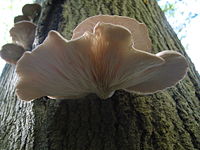
Effects of Whole-Lake Additions of Ethynylestradiol on Leech Populations.
Sign Up to like & getrecommendations! Published in 2020 at "Environmental toxicology and chemistry"
DOI: 10.1002/etc.4789
Abstract: Leeches are widespread, found in many freshwater habitats, and have diverse dietary habits. Despite their close phylogenetic relationships to Mollusca, a phylum with species affected by exogenous estrogens, it is unclear whether Hirudinea may also… read more here.
Keywords: lake additions; whole lake; additions ethynylestradiol; effects whole ... See more keywords

Efficient remediation of 17α-ethinylestradiol by Lentinula edodes (shiitake) laccase
Sign Up to like & getrecommendations! Published in 2017 at "Biocatalysis and agricultural biotechnology"
DOI: 10.1016/j.bcab.2017.02.004
Abstract: Abstract Removal of the endocrine disrupting chemicals (EDCs) which commonly pollute wastewater has been observed upon incubation with white-rot fungi. To date, there is no consensus on what is the optimal fungal source for the… read more here.
Keywords: ethinylestradiol; laccase; remediation; chrysosporium ... See more keywords

Algal extracellular organic matter mediated photocatalytic degradation of estrogens.
Sign Up to like & getrecommendations! Published in 2020 at "Ecotoxicology and environmental safety"
DOI: 10.1016/j.ecoenv.2020.111818
Abstract: Estrogens are among the most concerned emerging contaminants in the wastewater treatment effluent due to their sexual disruption in aquatic wildlife. The use of microalgae for secondary wastewater effluent polishing is a promising approach due… read more here.
Keywords: microalgae; extracellular organic; algal extracellular; ee2 ... See more keywords

Metabolism analysis of 17α-ethynylestradiol by Pseudomonas citronellolis SJTE-3 and identification of the functional genes.
Sign Up to like & getrecommendations! Published in 2021 at "Journal of hazardous materials"
DOI: 10.1016/j.jhazmat.2021.127045
Abstract: Synthetic estrogens are the most hazardous and persistent environmental estrogenic contaminants, with few reports on their biodegradation. Pseudomonas citronellolis SJTE-3 degraded natural steroids efficiently and metabolized 17α-ethynylestradiol (EE2) with the addition of different easily used… read more here.
Keywords: ee2 metabolism; metabolism; citronellolis sjte; ethynylestradiol ... See more keywords

Oriented bio-feeding control of the anaerobic biodegradation of ethinyl estradiol.
Sign Up to like & getrecommendations! Published in 2022 at "Chemosphere"
DOI: 10.2139/ssrn.4102662
Abstract: Up to 95% of hormones are excreted into domestic wastewater with urine or feces, but their macromolecules are difficult to biodegrade. This project studies the treatment of Ethinyl Estradiol (EE2) in swine wastewater in an… read more here.
Keywords: propionic acid; anaerobic biodegradation; acid; ethinyl estradiol ... See more keywords